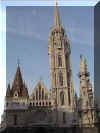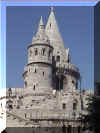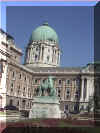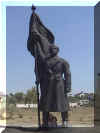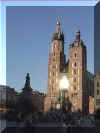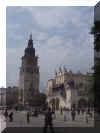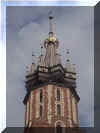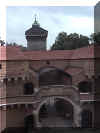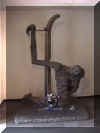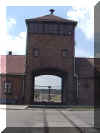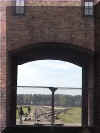



































PHOTOJOURNAL
JUNE 2-9, 2000
|
Day 30, Fri, June 2 – Arrived at 8:00 AM
with very little sleep and got a taxi to the Hilton Hotel – probably
the best located in town – high on castle hill with the city’s main
cathedral, Matthias, reflected in its windows.
Once again, Naomi did a great job of utilizing our accumulated
frequent guest points. We
logged onto the internet to pay some bills and upload some files to the
website. We know it’s
getting quite unruly and we’re looking into some of our supporter’s
suggestions to speed up download times, so please bear with us.
We had to go for a real Hungarian goulash lunch as I had been
talking about it ever since we had a lame facsimile of one in Russia.
I was not disappointed. As evidenced by prices and the standard of living
in Budapest, Hungary is in decent shape economically, and in fact is the
most “Western” looking and feeling of any country we’ve been to
date. This may be because
they had a head start of revolution and market reform decades before
Gorbachev’s Glasnost and Perestroika.
When an actual physical revolution was trounced by Soviets in
1956, they turned to a more subtle, unofficial protest by ignoring the
central party’s rulings and operating a sort of quasi-capitalist
economy. Hungary has had a
very odd and interesting history, beginning with Magyars descending from
the Ural mountains and conquering all they encountered.
When I told some Hungarians that my guidebook said the name
literally came from a legendarily insatiable hunger for rape, pillage
and even cannibalism, they laughed their asses off.
They were unsure of the derivation, but did point out that their
country is still “Magyar” in the local language.
They also have an odd history of “Magyarising” local
minorities into the culture, sort of the opposite of Nazi exclusion and
elitism. Their struggles to
maintain their own identity have been against many foes, including
Mongols, Saxons, Germans, Slavs, Ottomans and Austrians.
The latter alliance (or “subjugation” depending who you ask)
in the Hapsburg Austro-Hungarian Empire caused them to be dragged into
the first World War on the losing side and lose 2/3 of their land and
population when the empire was split between other countries by the
treaty of Trianon. The
biggest sore spot was the loss of Transylvania to Romania – the
resentment of this (amongst other things) was exploited by Hitler to
sucker Hungary into the losing side again in the next war.
The Hungarian population, particularly Jews and Gypsies, suffered
greatly and Budapest was bombed to pieces before being captured by the
Soviet army in 1945. The
communists took it from there until the 1956 uprising, which is where
this very brief history started. After lunch we walked around the castle district from the hotel. The gothic 15th century Matthias church has been rebuilt after the Turkish wars and World War II – it is now very impressive inside with incredible stained glass windows. Just outside the church is the Fisherman’s Bastion, a medieval edifice of stairs, archways, pavilions, and viewing platform overlooking the Danube River toward the Pest side. The views were great – particularly the standard post-card shot of the Parliament building across the river. The crowds are much thicker here than any other place we’ve been and we’ve even seen our first batches of stereotypical Japanese tourists with umbrellas, hats, white gloves and cameras at the ready. We watched them while enjoying the Budapest tradition of coffee and pastry at the historic Ruszwurm Café, opened in 1827. The baroque Royal Palace (or Buda Castle) was painstakingly rebuilt after it was left in rubble after a seven-week siege by Russians who finally drove Germans from Budapest. The palace contained great exhibits on the history of the Hungarian dynasties from centuries before the War. Hungary is no exception to our world tour of the history of warfare. In the five countries we've visited to date, we've seen all manner of proudly displayed weapons of war - swords, armor, shields, spears, chain suits, axes, arrows, daggers, clubs, maces, crossbows, guns, cannons, catapults. The unfortunate reality we are being reminded of is that the history of mankind is inextricably tied to the history of warfare. Territories have rarely been gained and nations founded by mere agreement of the residents, and everyone's hero/patriot/freedom fighter/savior/liberator/founding father is someone else's enemy/invader/traitor/tyrant/oppressor. I'm sure the stories we hear in Hungary are told quite differently in other parts of the world. As night fell, the tourist area around the hotel
and cathedral was deserted. We
walked around the bastion to the By the time we left, all the restaurants were closed, so we had to settle for overpriced room service. Goulash again – which was more than fine by me. The latest CNN news was as depressing as the last. Tourists are still held captive by terrorists in Malaysia and African wars (“civil” and otherwise) are still raging. An Eritrean spokeswoman was interviewed and asked “how do you respond to those who are saying you are waging a meaningless war over a sliver of useless territory at the cost of over US$ 1 million per day while your population starves”? Her answer was a terse “I do not believe there is a UN resolution stating that a poor country is not entitled to its sovereignty.” I was reminded of the old truism: “The primary objective of those in power is to remain in power”. *********** Day 31, Sat, June 3 – Had a great omelet breakfast at a café inspired by and named after Joan Miro. It’s one of those hip, young places that the post-communism generation has come to adore, but unfortunately breeds a snobby attitude. We then walked across the Chain Bridge, the most beautiful in Budapest, the views back across to castle hill rival those from the other side. We went through a market and book fair, then took the metro (very clean and efficient) to the City Park. There we visited the Museums of Fine Arts, with a great collection of paintings, and a gallery of modern art across the square. The modern art was a little more dubious, but there was one group of colored squares that was interesting. The centerpiece of this area is the Heroes’ Square, or sort of Brandenburg gate of Hungary. It includes statues of most of the national heroes, a huge column reminiscent of Nelson’s in London, and seven bronze horsemen representing the conquering Magyars. This is where demonstrations have been held, the Pope has said mass and foreign dignitaries lay memorial wreaths. It is also the home to dozens of tattooed, acrobatic skateboard freaks. We had a great dinner on the river facing Buda, where we could watch a portrait artist at work – he drew an uncanny resemblance of a little girl at the table next to us. For some reason, I was unable to convince Naomi to sit for one. Back at the hotel, I called my parents since I had been unable to reach them for their birthdays (May 26 and May 30). Only Dad was home. He said they had been reading the website and support our efforts very much. Although they are very proud of what we are doing, they are concerned that we may have “bitten off more than we can chew”. Of course he is right, we are not so naïve to think that the President of Eritrea gives a shit what we write on some website. Notwithstanding that, we will never know how much impact we can have on the world unless we try. Besides, they are the parents who taught me and my brothers to stand up for what we believe in. One thing Dad said that does stick with me is “those who want to do something can’t, and those that can do something won’t”. ********** Day 32, Sun, June 4 – Attended the church service at Matthias to hear the choir and organ music. It was very nice. Afterward, we took the metro to meet our Servas hosts, Kinga and Attila, who are a little younger than us and work at Graphisoft, one of the bigger software design firms in Hungary. Our Servas contacts have really been a bonus for this trip as they have provided us with instant friendly faces to discuss the local culture, history and economics in a very open atmosphere. You can’t necessarily have those types of discussions with strangers over a beer at the local pub (“pardon me, can you pass the beer nuts and tell me what you think of the treaty of Trianon?”). It also helps that the Servas organization shares many of our own beliefs in peace through friendships. In this instance, Kinga and Attila were great – we had a great lunch of stuffed crepes with them and another Servas traveler, Andrew, then headed out to Margaret Island, the former royal game park in the middle of the Danube. Since it was Sunday, it was full of a wide cross-section of the Budapest population and prime hunting ground for interviews with strangers. Kinga agreed to translate in Hungarian for us. We had some great ones – since the video portion of the website is still to be worked out, I will paraphrase their answers to “the most important thing in life”:
*************** Day 33, Mon, June 5 – We decided to take
a sort of mini-road trip (by taxi, tram and bus – what an adventure)
to a very unique attraction on the outskirts of town.
Szobor Statue Park is an open-air museum that houses many of the
Communist-era statues that once stood in Budapest’s public spaces.
It is an eerie collection of monuments to the “workers heroes”
of the times, highlighted by Lenin himself.
A combination lesson in art, history, oppression, propaganda, and
the black humor that characterized the Hungarian resistance movement.
It would even be sort of humorous if the topic at hand had not
caused so much pain to the country.
The gift shop sold a broad collection of communist-era books,
tapes, hats and medals (the same ones on sale in Russia) as well as
post-communist T-shirts. The
gates of the museum are inscribed with the poem “A Sentence on Tyranny”
by Gyula Illyes, published in 1956 at the time of the revolution. It
is 46 stanzas long, so only a few follow: Where seek out tyranny?
We tried to visit the elaborate gothic parliament
building, but we missed the last English-language tour.
Instead, we got a tour of the Opera House, one of the most
beautiful in the world and one-time scene of famous works of local We stopped by the St. Stephen’s Basilica, but it was closed for restoration. I’m kind of glad because once inside, I would have been drawn by morbid curiosity to view the gnarled mummified hand of St. Stephen himself, who was made an Apostle by Pope Sylvester II as a reward for converting to Christianity. Viewing body part relics is only slightly more disgusting than viewing Mohammed’s whiskers in Istanbul. We also stopped by the Synagogue, the second-largest in the world (after New York), which was desecrated as a detention camp by Nazis during the war. Ironic timing as we had just watched the special D-Day memorial services on CNN. It's hard to believe that the war that ended over 50 years ago is still so fresh in the minds and culture of Europe -I suppose it's a testament to the devastation it caused, not only physically but emotionally, spiritually and economically as well. After such a busy day, we had to avail ourselves of the comfort that tourists have been enjoying in Budapest for centuries – the thermal baths. We chose the most famous, Gellert, which has elevated the hot soak to an Art Nouveau marble and glass art form. Its huge labyrinth must host thousands per day for swim, steam, massage, wave pool, sunbathing and massage. They really know how to enjoy themselves. We kicked back for a couple hours, then the attendants did the kicking since it was closing time. After which we were too lazy to walk, so we took a taxi up Gellert Hill to the Citadella, overlooking the entire city. It was originally used by the Turks, but was built up in 1854 by Austrians to keep an eye on their rebellious “little brothers”. All in all, we had a wonderful time in Budapest and wish we had more time to explore the rest of Hungary. After fitting in everything we could, we unfortunately ran out of time for a decent dinner and had to settle for McDonalds before boarding our overnight train to Krakow, Poland. ****************** Day 34, Tues, June 6 – We arrived early at about 8:00 AM as usual and checked in to Hotel Fortuna, not far from the historic old town. Unfortunately, our room was not yet ready so we had to stroll around to find breakfast, then into the main market square, Rynek Glowny. The square is supposedly the largest medieval square in Europe and may well be the most well preserved. It is bounded on all sides by wonderful architecture and beautiful churches, and has an old covered market and town hall clock tower in the center. Due to its size, it is supposedly home to the second largest population of pigeons in Europe, a fact that did not escape Naomi’s attention, as she absolutely adores the sweet little “rats with wings”. The square, as well as the rest of Old Town is
remarkably well preserved because the Nazis were forced to abandon their
plans for complete destruction by a sudden unexpected Russian advance.
The Nazi invasion of 1939 to effectively start World War II was
just the latest in Poland’s long history of invasions, conquests and
occupation by foreign powers. At
various times, Teutonic Knights, Tatars, Swedes, Russians, Prussians,
Napoleonic troops and Austria have all laid claim to Poland.
There were even three different “partitions” of Poland in one
23-year period in the late 18th century.
One of the heroes of the fight for independence, Tadeusz
Kosciuszko, is known to me as the namesake of numerous localities in my
home state of Indiana, USA, having helped the upstart colonists oust the
British from the continent. The
Polish democratic constitution is the second in the world after the USA.
World War I crippled the occupying powers, providing Poland an
opportunity to free itself, including key victories over Russia.
The subsequent non-aggression treaties with both Germany and
Russia were virtually ignored by a secret agreement between Hitler and
Stalin to partition Poland once again.
As a result, the Polish population suffered both Nazi and Soviet
concentration camps. The eventual Russian “liberation” put Poland
square on the road to the Warsaw Pact and communism until the Solidarity
labor movement led by eventual President Lech Walesa started
revolutionary thoughts churning all over the Eastern Block in the
1980's. The historic
oppression of Poland’s nationalism and religion has not only created a
country of incredible pride for its people and history, but also has
ironically produced the first non-Italian pope in 400 years, John Paul
II (Cardinal Karol Wojtyla). We start our visit by climbing the clock tower to get a view of the city. The Old Town is clearly visible by the jumbled cobblestone streets surrounded by a grassy ring where the moat outside the city walls used to be before it was filled in and planted. Despite its age, Krakow has a young, cosmopolitan feel, mostly due to the University, the second oldest in Europe, founded in 1364. The city has apparently been listed by UNESCO as one of the world’s 12 most precious cultural sites and it is one of the eight cities named “2000 European City of Culture”. This is noted with pride on numerous posters around the city. Also, if the history and beauty aren’t intriguing enough, it also has some great old traditions, legends and superstitions. For example, a bugle call (hejnat) is played live from the tower of St. Mary’s church every hour, but it is cut short in mid-note to honor the player whose throat was punctured by an invading Tatar’s arrow. Legend has it that the mismatched towers of the church were due to a competition between two architect brothers which got so heated that one brother stabbed the other to death then plunged the knife into his own chest. We visited St. Mary’s with its incredible stained glass and carved wooden alter piece, then the other main churches in the old town, St. Anne’s, the Franciscan and the Dominican. We also walked around the amazingly well preserved medieval fortifications at the Barbican. We had a great, hearty Polish dinner that reminded me of the meat and potatoes cuisine I grew up on. ************** Day 35, Wed, June 7 – We had planned to
go to Wawel Castle, the historic home to Polish rulers, but it was
overrun with kids on school trips. We decided to visit museums including
the cloth hall, which houses the notorious “Ecstasy” which was
judged too lurid for public display in 1894 and the Czartoryski Museum,
housing a broad range, including Da Vinci’s unusual
“Madonna with Ermine”. We had lunch near the US Consulate, where huge
crowds awaited the results of their visa applications, bought our next
tickets at the train station, then had a delicious kebab dinner before
exploring Krakow’s legendary underground ************** 12:40 AM – In 9 hours we will be on a bus to Auschwitz, the scene of the most horrific human behavior in history. I know what to expect, but I am still very apprehensive. I have seen all the movies, read the books and heard the stories of survivors, but I don’t think anything can really prepare you for bearing witness to the worst of what mankind can do to itself. I visited Dachau on my first trip to Europe in 1987, but I was too busy being a kid, drinking and carousing, to grasp the full meaning of what I saw. Now 13 years (and seemingly many lifetimes) later, I’ve been lucky enough to experience the incredible goodness of life and I’ve also seen enough of the bullshit we create to get fed up and try to change some of it. If our mission is to minimize the wasted energy caused by hatred, prejudice and violence, then we could not have planned our world tour without a stop in Auschwitz. And if our belief in the better side of human nature and human potential is to last, it must withstand the horrible truth of what the worst side of human nature is capable of. Our faith in the inherent goodness of mankind faces its strongest test tomorrow. ************** Day 36, Th, June 8 – It is now many days
since June 8 as I write this; mostly because I haven’t figured out
exactly what to say. The
events that occurred at Auschwitz during the war cannot really be
explained effectively in words and The Auschwitz (Oswiecim) museum is located 75 KM from Krakow. We took an English-language tour by bus. From the moment of arrival, you are enveloped in the oppressive sadness of the place that is really impossible to explain. What began as a detention center for Polish prisoners and Soviet POWs, eventually became the stage for the planned implementation of Hitler’s “final solution” to “the Jewish problem” – i.e. total annihilation of the race (Hitler: " If you wish the sympathy of broad masses, then you tell them the crudest and most stupid things "). Auschwitz was not so much a “labor” or “concentration camp” as a massive killing machine, which liquidated up to 1.5 million people. The more appropriate term used by the museum guides: “Death Camp”. Over 90% of the victims were Jews from all over the European territories occupied by Nazi Germany. Others were captured POWs, political prisoners, gypsies, criminals, Jehovah’s witnesses and homosexuals. What strikes one most about the camp is the absolutely cruel efficiency of the operation, as if they were always looking for better ways to be evil. The treatment by the guards and administrators was more like operating a beef slaughterhouse – the only difference is that the “beef” at Auschwitz was forced into work and other humiliations before being killed – at least cows can pretty much do what cows do naturally until the fateful day. At Auschwitz, it was not enough to be imprisoned, inmates were also used as slave labor for the German forces and nearby civilian companies. It was not enough to carry their own burden, but if another passed out or died at work, they had to be carried home so as not to miss the next roll call. It was not enough to lose all possessions, they also lost families and identities as their identification numbers were tattooed into their skin. It was not enough to lose all sanitation and medical care, they were also subjected to medical experiments in sterilization, diseases, chemicals and poisons. It was not enough to simply punish “transgressors”, but more creative methods were devised such as starvation, suffocation, flogging, hanging, and standing with three others in a cell 3 feet square for days. It was much too inefficient to shoot inmates, so the Nazis devised gas chambers, which could kill 2000 people in 15 minutes. It was not enough to see this happen to their friends, but other inmates had to shave the heads of the corpses, pull their gold teeth out, and load the incinerators. And even in death, the corpses were used efficiently – the ashes as fertilizer and the hair was used as mattress stuffing or made into cloth for German tailors. The outrageousness of it all would almost be unbelievable if we had not seen it with our own eyes – like a vision of hell that Dante could never have imagined. The organized tour starts through the famous iron archway that reads “Arbeit Macht Frei” (Work Brings Freedom) and continues through the original and rebuilt barracks of the camp. Each building contains exhibits which explain exactly how the death machine was organized and operated: First the round-up from their homes (they were told of relocations to jobs and properties elsewhere); then the deportation (in sealed standing-room only cattle cars for up to 7 days); then arrival at the camp and summary selection (to the left meant you were fit enough for slave labor, to the right meant immediate death); then to changing rooms (they stripped calmly because they were told they were getting showers); then to the shower rooms which oozed poisonous gas instead of water; and finally to the crematoriums, pyres and mass graves. The photos, diagrams, models and documents are harrowing, but the most striking rooms are those filled with the physical evidence of the atrocities – the eyeglasses, hairbrushes, clothes, shoes, artificial limbs, cooking utensils, suitcases, tools of trade, and toys. Warehouses literally overflowed with plundered goods as the guards could not ship them back to Germany fast enough. Thirty of the warehouses were burned (and some gas chambers blown up) by retreating Nazis in a clumsy attempt to hide the activities of the camp before abandoning it. The most disgusting room is filled to the ceiling with some of the 7 tons of hair, which had not yet made it to the cloth factory by the time the camp was liberated by Russians on January 27, 1945. The tour continues to the guards’ office, with a portrait of Hitler on the wall, through the “punishment cells” with inmates’ scratched-out artwork inside, to the gallows for hanging and the “death wall” for firing squad killings. We then saw a 20-minute newsreel documentary filmed by Russians as they liberated the camp. The skeletal inmates were in shock and did not even have the strength to smile. After the film, a bus takes you 3 KM to Auschwitz-II (Birkenau), a much bigger camp of 300 structures covering 425 acres. This is where up to 100,000 inmates were held in converted horse stalls. Exhibits there show the actual living conditions in the bunk rooms and toilets, as well as the infamous railroad track and selection platform featured prominently in Steven Spielberg’s “Schindler’s List”. The whole scene is eerie and you leave the town virtually numb. Naomi and I bought a book, “By Bread Alone” written by a survivor, Mel Mermelstein , who won a court case in 19 81 against neo-nazis who claimed that the Holocaust was a hoax invented by Jews to gain worldwide sympathy So how do I feel after experiencing all of this?
I honestly don’t know. I
feel a lot of things – most of which cannot be expressed adequately.
There is infinite sadness in the ability of mankind to inflict so much
damage on itself; there is some anger at God, fate, destiny, whatever,
for allowing this to happen; I feel admiration and respect for the
abilities of the survivors to conquer all manner of hatred,
discrimination, and degradation; I feel pride in the writers,
historians, and filmmakers who have refused to allow this episode to be
forgotten in the hope that education will contribute to prevention.
I feel hope and I am encouraged in the number of people who
fought this belief system and continue to struggle against genocide
today. At the same time I
am also discouraged by the recent events in Africa, India, Indonesia,
and the former Yugoslavia, as if we have not evolved as a race at all in
the past 50 years – as a matter of fact we may have 75 KM and 500 years from Auschwitz an inscription
was made in the archway leading to the great hall of the Jagiellonian
College in Krakow: “Plvs
Ratio Qvam Vis” – “Reason Above Violence”.
This concept must have been too threatening to the Nazi ideology
as the professors of the University were among the first to be deported
to concentration camps. This
story should be required reading for all the students of all the schools
in all the world. Perhaps
it will sink in some day. ***********
********** Day 37, Fri June 9 – After the drain of yesterday, we received an amazing boost of energy and encouragement from a group of school kids on a trip through the park. They had surrounded a troupe of musicians and their teacher led them in songs and dances. Their energy and joy was infectious as all the adults walking through the park stopped to laugh with them. As they had in other countries, kids have provided the most telling example of the commonality of all of us. They may have been singing in Polish, but their laughter truly had no language.
After Wawel, we had a walk around the banks of the Vistula and interviewed a couple of girls:
Back in the old town we discovered that today was a very special holiday that called for parades of marching bands and horses. I asked around and got confusing answers, but I think it was the anniversary of a miracle battle won by an outnumbered Polish force against the Russians as well as the “marriage of Poland with the Sea”, commemorating the return of lost territory. We had some great Kielbasa sausages and baked potatoes from an open fire barbeque set up in the square as horses and military types marched by. One of the bands played “American Pie”. I hoped they were familiar with the song in the 70's, ages before Madonna butchered it. As Naomi checked email at an incredible internet bar in a centuries-old cellar, I walked around the square talking to strangers:
********* To carry on with the rest of our adventure, please click here: Photojournal June 10 - 19 If you have any comments, suggestions, or other feedback, please see our contact information and send us a note. Thanks for your support!
|
